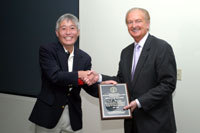GM Executive Named Honorary Fellow by Stanford University
 |
Detroit June 1, 2006; Gary Cowger, group vice president of global manufacturing and labor relations, was recently named an honorary fellow by Stanford University’s Manufacturing Modeling Laboratory. He is the fifth recipient in twenty years of the esteemed award.
The honorary fellowship is presented by the Stanford University Mechanical Engineering Department to a corporate officer who has demonstrated a consistent, long term commitment to innovation in engineering education as it relates to the principles of design for manufacturability and its applications to industry.
Cowger co- founded the Design for Manufacturability (DFM) distance learning course at Stanford in 1986 with GM Technical Fellow Ed Alef and Dr. Phil Barkin (deceased), a Stanford University Professor who taught the initial DFM courses.
“It is a great honor to receive the award from Stanford University. I can’t think of anything that would please me more than having it be for design for manufacturability,” said Cowger, “a process that has saved GM over $43 million over the last 20 years.
Dr. Kos Ishii, director of the Manufacturing Modeling Laboratory and the co-director of the Global Supply Chain Management Forum at Stanford praised Cowger’s continuous involvement in the expansion of DFM courses.
“ Gary has always been a big supporter of DFM at Stanford. Since launching the program, he has secured financial backing through GM’s Technical Education Program and continues to track how the curriculum is progressing,” said Dr. Ishii.
The partnership between GM and Stanford University is one of the first and most extensive DFM courses to address structured methods and innovation implementation in creating world class vehicles. DFM participants must complete two three -credit courses culminating in original solutions for GM defined projects using the tool box of applications presented in the course. Since it’s founding, 1,000 GM employees have completed DFM courses and have saved GM more than $43 million by applying the course theories and concepts.


